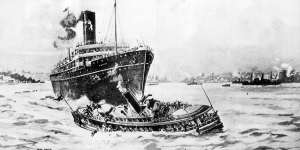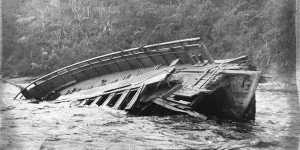APPALLING HARBOUR DISASTER.
Ferry Boat Struck by Mail Steamer.
GREYCLIFFE SMASHED AND SUNK.
Killed and Missing Estimated at 37 Persons.
ABOUT FIFTY PERSONS TAKEN TO HOSPITAL.
In the harbour yesterday afternoon the R.M.S. Tahiti ran into the ferry boat Greycliffe,cutting her in halves and sinking her.

An artist’s impression of the Greycliffe ferry disaster as published in the Sydney Mail.Staff
The bodies of eleven persons who were on the Greycliffe have been recovered. Twenty six are reported to be missing,and more than 50 injured were taken to hospital.
THE DISASTER.
The greatest disaster that has ever occurred on Sydney Harbour took place yesterday afternoon about 4.30 o’clock,when the Union Steamship Company’s R.M.S. Tahiti rammed and sank the Sydney Ferry Company’s steamer Greycliffe,off Bradley’s Head.
The accident was accompanied by appalling loss of life. The latest reports last evening stated that 11 bodies had been recovered,26 persons were reported missing and over 50 had been treated at Sydney Hospital for injuries received in the collison.
It is feared that further loss of life has resulted. Many of the passengers on the Greycliffe were children returning from school in the city or from the sports meeting of the Public Schools’ Amateur Athletic Association at the Cricket Ground.

Part of the Greycliffe’s hull.Australian National Maritime Museum
Strangely,however,children do not figure largely in the list of dead,although many of them were treated for injuries.
An unusual feature of the disaster is that both vessels were travelling in approximately the same direction at the time the collision occurred. The Tahiti had sailed from No. 5 Darling Harbour for New Zealand,at 4 p.m.,and the Greycliffe had left Circular Quay at approximately the same time,with about 125 passengers on board,on her usual run to Vaucluse,Parsley Bay and Watson’s bay. The ferryboat for that trip is generally known as the “school boat,” as she carries many children returning from schools in the city.
It is not known definitely how the collision occured. The Tahiti,which is commanded by Captain Aldwell,had reached a point nearly opposite Bradley’s Head when the accident happened.
The collision occurred so suddenly that the passengers on board the Tahiti did not realise what had happened. The screams of women and children on the stricken Greycliffe rudely enlightened them.

Captain William Barnes of the Greycliffe.Staff photographer
Apparently the Greycliffe was broadside on to the mall steamer. At the moment of impact,the sharp bow of the Tahiti hit into the wooden superstructure of the ferry boat,at first pushing it forward and turning it over,and then tearing right through the smaller vessel amidships,one half of the Greycliffe going to the south side of the Tahiti and the other to the north.
In a moment all was confusion. Terrible scenes were witnessed as the ferryboat’s passengers struggled to free themselves from the wreckage,which finally sank. The engine-room boiler burst when it became submerged,adding further to the horrors of the situation for the unfortunate passengers. In a moment many were struggling in the swirling waters and many pitiful scenes were witnessed. Forgetting their danger some of the survivors immediately went to the assistance of others and placed them in comparative safety until assistance arrived. A fireman on the Tahiti dived overboard,rescued two children,and assisted others.
In a remarkably short space of time vessels of all description had hurried to the scene and searched for survivors among the litter of wreckage that covered the surface of the harbour:many were thus saved. It is feared that many of the passengers were fatally injured when the collision occurred.
The Tahiti swept on for some distance after cutting through the Greycliffe before she could be pulled up. Eventually she returned,anchored opposite Point Piper,and lowered boats to go to the rescue of the survivors.
The steel plating of the mail steamer prevented her being damaged,and all that was noticeable were two long scratches on either side of her bows,where the wooden superstructure of the Greycliffe had scraped
off the paint in passing. She was able to continue her voyage to New Zealand that evening.
In February 1928,the city coroner (Mr Fletcher) found that there was negligence of the part of the captains of both vessels,but not criminal negligence.